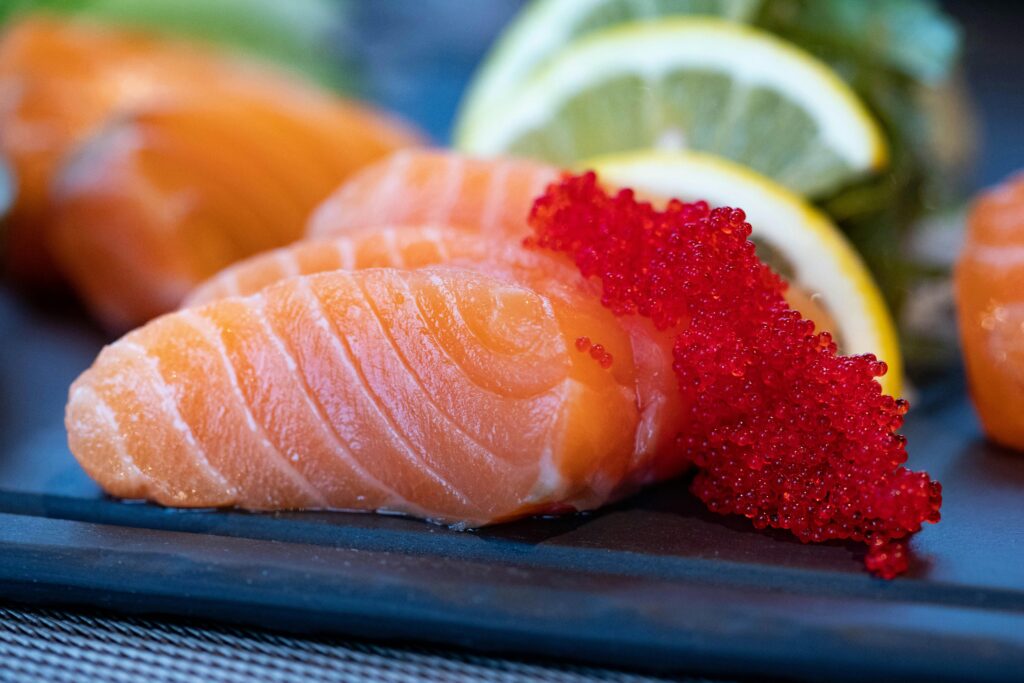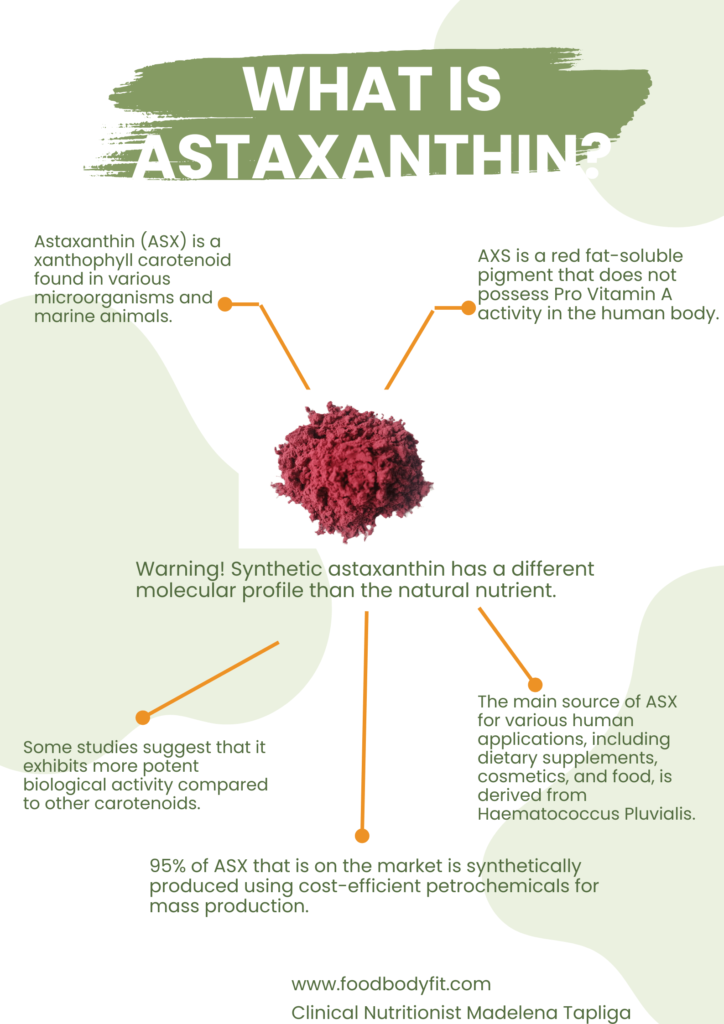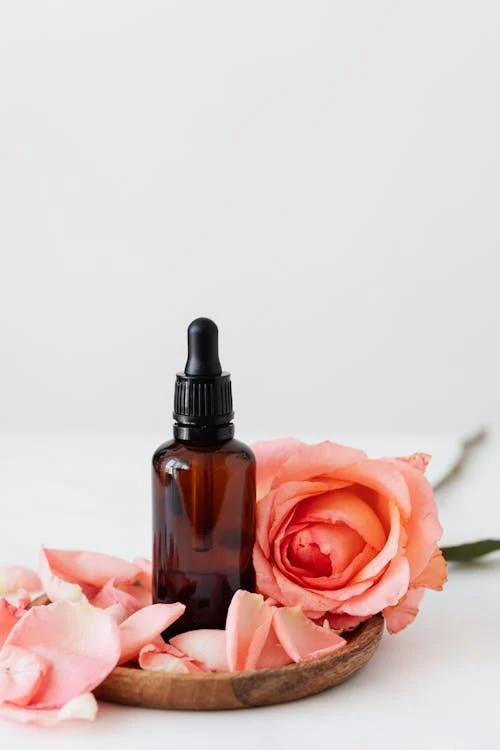Table of Contents
Astaxanthin has been linked to numerous health benefits, including skin health, eye health, diabetes and cancer prevention, cardiovascular disease, cytokine storm in COVID-19, weight loss, and immune system support.
It is considered one of the best carotenoids due to its ability to protect cells, lipids, and membrane lipoprotein against oxidative damage
As a Clinical Nutritionist at the Holistic Health Nutrition clinic, I have received numerous questions regarding astaxanthin health benefits and its role in promoting overall well-being. In this article, we will explore the astaxanthin benefits and side effects, and address some of the common queries such as how much Astaxanthin per day.
From its role in reducing oxidative stress and inflammation to supporting cardiovascular health and enhancing immune function and amazing skin benefits ASX has proven to be a valuable ally in maintaining optimal wellness.
From its role in reducing oxidative stress and inflammation to supporting cardiovascular health and enhancing immune function and amazing skin benefits astaxanthin has proven to be a valuable ally in maintaining optimal wellness.
Join the conversation as we explore the incredible benefits, optimal dosage, and the ultimate hack to incorporate ASX into your daily routine effortlessly! Let’s dive in!
What is the difference between natural and synthetic astaxanthin?
Are there any synthetic astaxanthin health benefits?
ASX safety concerns have been raised, particularly regarding the use of synthetic ASX for human consumption.
Antioxidant Properties:
- Natural astaxanthin (NAst) exhibits significantly stronger antioxidant properties compared to synthetic astaxanthin (S-AX)
- NAst is over 50 times stronger in singlet oxygen quenching and approximately 20 times stronger in free radical elimination than S-AX1
- Synthetic astaxanthin is significantly inferior to algal-based astaxanthin as an antioxidant and may not be suitable as a human nutraceutical supplement until long-term safety and health benefits are established.
- S-AX, synthesized from petrochemicals, has not been demonstrated to be safe for human nutraceutical use and lacks long-term safety data
Safety and Bioavailability:

NAst is considered safe for human consumption and has been used extensively in nutraceuticals with established health benefits
NAst has better bioavailability and is more effective in preventing oxidative stress without toxicity2
- S-AX, synthesized from petrochemicals, has not been demonstrated to be safe for human nutraceutical use and lacks long-term safety data3
Production and Environmental Impact

NAst is produced from microalgae like Haematococcus pluvialis, which is considered eco-friendly and sustainable
The production of S-AX is less costly but involves petrochemical processes, raising environmental and health concerns4.

Applications and Efficacy
- NAst is widely used in nutraceuticals, cosmetics, and food industries due to its superior antioxidant capacity and safety profile1 3 4 5.
- S-AX is primarily used in aquaculture to pigment the flesh of salmonids and has not been tested for health benefits in humans
The main source of ASX for various human applications, including dietary supplements, cosmetics, and food, is derived from Haematococcus Pluvialis.
This article will exclusively focus on natural ASX and its attributes within the context of the discussion

Astaxanthin health benefits
ASX has amazing antioxidant power linked to various health benefits including prevention of cardiovascular disease, immune system enhancement, bioactivity against Helicobacter pylori, and cataract prevention.
ASX has gained attention due to its potential pharmacological effects. These include anticancer, antidiabetic, anti-inflammatory, antioxidant, and neuro-, cardiovascular, ocular, and skin-protective effects. Furthermore, it has demonstrated effectiveness in skin cancer chemoprevention.
Humans do not make Astaxanthin.
Astaxanthin products are utilized in various commercial applications, available in a range of dosage forms such as tablets, capsules, syrups, oils, soft gels, creams, biomass, and granulated powders.
Patent applications for Astaxanthin apply to food, feed, cosmetics, and nutraceutical industries, including aquaculture,
Is astaxanthin the most powerful antioxidant?
- ASX is more bioactive than zeaxanthin, lutein, and β-carotene furthermore exhibits greater antioxidant activity compared to other carotenoids like lutein, lycopene, α-carotene, and β-carotene(1)
- Powerful antioxidant. Immune cells are particularly vulnerable to oxidative stress due to the high concentration of polyunsaturated fatty acids in their plasma membranes. As a result, they tend to generate more oxidative products. An increase of reactive oxygen and nitrogen species can disrupt the delicate balance between oxidants and antioxidants, leading to the degradation of cell membranes, proteins, and DNA. Hence, in conditions of increased oxidative stress, such as during disease states, dietary antioxidants play a pivotal role in maintaining an optimal oxidant-to-antioxidant equilibrium.
- Immune-Enhancing Effects. Activated T cells and NK cells produce interferon-γ (IFN-γ), which is involved in immune regulation and B cell differentiation
- Cancer. Due to antioxidant compounds, ASX can decrease mutagenesis and carcinogenesis by inhibiting oxidative damage to cells, enhancing immune responses, and potentially exerting antitumor activity
- Anti-inflammatory properties, which can help reduce inflammation in the body and alleviate symptoms associated with various inflammatory conditions such as rheumatoid arthritis, canker sores, carpal tunnel syndrome, and “tennis elbow”.
- Promotes integrated immune response. Repair DNA damage. Various studies demonstrated that dietary ASX has the potential to reduce DNA damage and acute phase protein levels, while simultaneously enhancing immune response.
- Effect on Helicobacter pylori: Multiple studies showed 40 mg/day of AXT significantly decreased symptoms linked with acid reflux, bacterial load, and gastric inflammation. Furthermore improved the well-being of the participants.
- Naproxen-induced gastric and antral ulcers were effectively prevented, and lipid peroxidation in the gastric mucosa was inhibited with high protection.
- Liver Fibrosis. Liver fibrosis is a wound-healing response, triggered by various pathological factors including hepatitis viruses, metabolic disorders, and alcohol consumption. In a Chinese study, 80 mg/kg of astaxanthin showed a notable protective effect against liver fibrosis, suppressing various profibrogenic factors
- Anti-Diabetic Activity. Oxidative stress levels are very high in diabetes mellitus patients. It is induced by hyperglycemia, due to the dysfunction of pancreatic β-cells and tissue damage in patients. ASX could reduce the oxidative stress caused by hyperglycemia in pancreatic β-cells and also improve glucose and serum insulin levels. Furthermore, it has shown potential in preventing diabetic nephropathy by reducing oxidative stress and renal cell damage, according to these studies.
- Gingival Wound Healing Following High Glucose-Induced Oxidative Stress Diabetic complications are linked to oxidative stress caused by high blood glucose levels, resulting in slow wound healing. Periodontal disease is the result of chronic inflammation of the gum tissues. This study (2022) reported enhanced gingival wound healing due to AXS consumption.
- Astaxanthin benefits eyes. Increased screen time often leads to eye strain, blurred vision, and tension in the muscles of the shoulders and lower back. Extensive research has been conducted on astaxanthin and its positive impact on vision. Multiple clinical trials conducted by Japanese researchers have demonstrated that ASX enhances visual acuity and reduces eye fatigue. Incorporating astaxanthin into a daily diet can potentially alleviate eye fatigue in individuals who spend prolonged periods working on computer monitors.
- Alleviate the risk of cytokine storm in COVID-19 due to antioxidant properties and anti-inflammatory compounds that lead to the prevention of oxidative damage. ASX is a potent inhibitor of pro-inflammatory cytokines, such as IL-1β, IL-6, IL-8, and TNF-α
- Male Fertility and Reproduction. A double-blind clinical trial, where thirty males were recruited from infertile couples, where female partners did not have infertility problems, showed a significant increase in sperm velocity, the pregnancy rate was 54.5% for the ASX group compared to 10.5 % placebo group.
- Astaxanthin benefits weight loss and helps improve metabolic health by reducing oxidative stress in overweight and obese individuals, including smokers, supporting healthy blood sugar levels, and promoting weight loss
- Improve cognitive functions: A small clinical trial shows multiple brain benefits such as memory improvement and other Higher Brain Functions. Further research is needed.
- Effects on Circulation. As people age, their red blood cells (RBCs) become more vulnerable to oxidative attack, leading to damage in the RBC membrane phospholipids and reduced oxygen-carrying capacity. Multiple studies suggest that AXS can potentially improve microcirculation.
- Polycystic ovary syndrome (PCOS). ASX administration can be beneficial for PCOS patients. PCOS is characterized by a combination of endocrine and metabolic dysfunctions, leading to symptoms like insulin resistance, hyperandrogenism, gonadotropin disorder, and anovulation dysfunction. PCOS is a significant cause of anovulatory infertility in women. Furthermore, patients with PCOS experience endoplasmic reticulum (ER) stress. A small Iranian clinical trial showed that taking 12 mg/day of ASX for 60 days can alter the molecular pathways of ER stress through its antioxidant activity, demonstrating its potential as a natural supplement.ASX can impact gene and protein expression related to the protein response in GCs. Additionally, ASX might regulate oxidative stress markers in patients’ FF.
- Muscle Performance and Endurance
- Effect on Mitochondrial Function. In a series of experiments using different cultured cell lines, ASXastaxanthin was found to enhance cell survival under oxidative stress caused by antimycin A, which increases mitochondrial ROS generation. The researchers discovered that astaxanthin reduced the production of oxygen radicals within the mitochondria, protecting it from a decline in membrane function that typically occurs over time. Additionally, astaxanthin increased mitochondrial activity by boosting oxygen consumption without generating more ROS.
Astaxanthin skin benefits
Molecular and morphological changes in aged skin not only compromise its protective function but also contribute to the manifestation of skin symptoms.

The process of skin aging involves oxidative events that result in DNA damage, inflammatory response, decreased antioxidant production, and the activity of matrix metalloproteinases (MMPs) that break down collagen and elastin in the dermal layer of the skin.
These include excessive dryness, pruritus, increased susceptibility to wrinkles formation, depigmentation, fragility, impaired wound healing, altered drug permeability, reduced ability to sense and respond to mechanical stimuli, skin irritation, and elevated tumor incidence.
Haematococcus pluvialis extract skin benefits
Haematoccocus pluvialis microalgae are the primary natural source of astaxanthin, boasting the highest concentration of up to 4% in dry biomass.
It is used in vitamin mixtures, dietary supplements, and protective creams.
- Reduces the appearance of fine lines and wrinkles by promoting collagen production, which can improve skin elasticity and reduce the appearance of fine lines and wrinkles. Several clinical studies have reported the effects of ASX in suppressing hyperpigmentation, inhibiting melanin synthesis, and photoaging, and reducing wrinkle formation.
- Reduce skin inflammation and improve the appearance of fine lines and wrinkles in aging skin
- Increases skin elasticity and moisture content: making it beneficial for dry and mature skin types.
- Assists with skin renewal by minimizing the effects of reactive oxygen species (ROS), which can break down the collagen matrix and increase levels of matrix metalloproteinases (MMP) leading to wrinkle formation and loss of elasticity;
- Reduces hyperpigmentation and age spots
When it comes to considering a higher dosage of skin treatment or adjusting your dietary intake, it’s always a smart move to consult with your trusted nutritionist or doctor. They’ll provide the expert guidance you need to make informed decisions about your health and well-being!
Food supplement recommendations
It is recommended to take AXS with omega-3-rich seed oils such as chia, flaxseed, fish, walnuts, and almonds
Absorption and bioavailability

Astaxanthin’s bioavailability is substantially affected by meal timing and by smoking. It is facilitated in the presence of fat or other lipids, due to fat-soluble compounds. It is much better absorbed when taken just after a meal than on an empty stomach, high amount of carotenes and it’s 40% less bioavailable in individuals who smoke.
The combination of astaxanthin and fish oil has been found to promote hypolipidemic and hypocholesterolemic effects in plasma.
Furthermore, this combination has demonstrated an increase in the phagocytic activity of activated neutrophils, compared to when astaxanthin and fish oil are used individually
Safety of Astaxanthin
Extensive tests conducted by Hoffman La Roche, including assessments for acute toxicity, mutagenicity, teratogenicity, embryotoxicity, and reproductive toxicity, have conclusively affirmed the safety of the product.
Excellent safety and tolerability, with no side effects when it is consumed with food.
What is the Astaxanthin dosage per day?
- How Much Astaxanthin per day?
- How much astaxanthin is safe?
- Astaxanthin 10 mg benefits.
- A single 10 mg dose can persist in the blood for 24 hours and a 100 mg dose for 76 hours
- Astaxanthin supplement 2-4 mg per day is the recommended dose
Is 12 mg of astaxanthin too much?
Clinical studies have demonstrated the safety of orally administered AXS at doses ranging from 4 mg to 100 mg/day, with no adverse or toxic effects observed.
Exceptional health benefits can be achieved with modest dietary intakes of 40 mg/day (2)
Do I need to take vitamin C if I take astaxanthin? What vitamins should not be taken with astaxanthin?
AXS offers superior protection compared to Vitamin C. Its unique molecular structure allows it to be present inside and outside the cell membrane. However, one study reported lowered bronchoalveolar lavage fluid inflammatory cell membrane after feeding AXS with Ginco biloba extract and Vitamin C.
What does astaxanthin do for the skin?
Recent clinical human studies showed a significant improvement in skin condition and appearance when 6 mg /day oral supplementation and 2 ml topical application of astaxanthin derived from microalgae Haematococcus Pluvialis.
Are there any other cosmetic benefits of astaxanthin?
Protects against sun damage: can protect the skin against sun damage and reduce inflammation and dryness.
Conclusion
Astaxanthin has many incredible health benefits and is considered one of the most powerful carotenoids on the market.
It may be the secret to enhancing your overall health and wellness. It has been proven to protect cells, lipids, and membrane lipoprotein while promoting anti-aging effects on the body
Adding astaxanthin to your daily regimen will undoubtedly benefit your overall well-being in numerous ways due to its impressive antioxidant potential.
All in all, for individuals looking for supplemental help with their health goals involving skin health, eye health, diabetes and cancer prevention, cardiovascular disease, weight loss, and immune system support – we suggest you look into taking astaxanthin as it could be the key to improved health and longevity!
And finally: do you plan to take Astaxanthin? Let us know!
- Capelli, B., Bagchi, D., & Cysewski, G. (2013). Synthetic astaxanthin is significantly inferior to algal-based astaxanthin as an antioxidant and may not be suitable as a human nutraceutical supplement. Nutrafoods, 12, 145-152. https://doi.org/10.1007/S13749-013-0051-5. ↩︎
- Rizzardi, N., Pezzolesi, L., Samorì, C., Senese, F., Zalambani, C., Pitacco, W., Calonghi, N., Bergamini, C., Prata, C., & Fato, R. (2022). Natural Astaxanthin Is a Green Antioxidant Able to Counteract Lipid Peroxidation and Ferroptotic Cell Death. International Journal of Molecular Sciences, 23. https://doi.org/10.3390/ijms232315137. ↩︎
- Capelli, B., Bagchi, D., & Cysewski, G. (2013). Synthetic astaxanthin is significantly inferior to algal-based astaxanthin as an antioxidant and may not be suitable as a human nutraceutical supplement. Nutrafoods, 12, 145-152. https://doi.org/10.1007/S13749-013-0051-5. ↩︎
- Stachowiak, B., & Szulc, P. (2021). Astaxanthin for the Food Industry. Molecules, 26. https://doi.org/10.3390/molecules26092666. ↩︎

[…] including prominent xanthophyll derivatives such as β-carotene, lycopene, lutein, and zeaxanthin. Lutein and zeaxanthin, also found in the human eye’s macula, are associated with cognitive function improvement, […]
[…] phenols and flavonoids found in Turkey Tail Mushrooms help reduce inflammation and boost immunity. Antioxidants also play a role in heart health by preventing oxidative damage to lipids and proteins, reducing […]